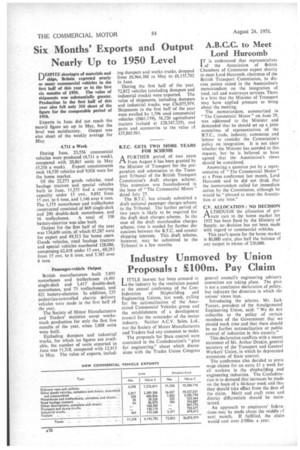Six Months' Exports and Output Nearly Up to 1950 Level
Page 32

If you've noticed an error in this article please click here to report it so we can fix it.
DFSPITE shortages of materials and ships, Britain exported nearly as many commercial vehicles in the first half of this year as in the first six months of 1950. The value of shipments was substantially greater. Production In the first half of this year also fell only 310 short of the figure for the comparable period of 1950.
Exports in June did not reach the record figure set up in May, but the level was satisfactory. Output was also short of the weekly average for May.
9,711 a Week
During June, 23,556 commercial vehicles were produced (4,711 a week), compared with 20,865 units in May (5,216 a week). Export commitments took 14,530 vehicles and 9,026 were for the home market.
Of the 22,273 goods vehicles, road haulage tractors and special vehicles built in June, 11,235 had a carrying capacity under 15 cwt., 9,892 from 15 cwt. to 6 tons, and 1,146 over 6 tons. The 1,175 rnotorbuses and trolleybuses constructed consisted of 869 single-deck and 290 double-deck motorbuses, and
16 trolleybuses. A total of 108 battery-electrics was also built,
Output for the first half of the year was 134,600 units, of which 85,287 were for export and 49,313 for home users. Goods vehicles, road haulage tractors and special vehicles numbered 128,086, comprising 62,418 under 15 cwt., 60,283 from 15 cwt. to 6 tons, and 5.385 over 6 tons.
Passenger-vehicle Output
British manufacturers built 5,893 motorbuses and trolleybuses (4,401 single-deck and 1,417 double-deck motorbuses, and 75 trolleybuses), and 621 battery-electrics. In addition, 235 pedestrian-controlled electric delivery vehicles were made in the first half of the year.
The Society of Motor Manufacturers and Traders' statistics cover workstruck production for only the first five months of the year, when 2,808 units were built.
Excluding dumpers and industrial trucks, for which no figures are available, the number of units exported in lune was 11318, compared with 12,913 in May. The value of exports, includ
ing dumpers and works trucks, dropped from £6,966,388 in May to £6,155,702 in June.
During the first half of the year, 72,852 vehicles (excluding dumpers and industrial trucks) were exported. The value of shipments, including dumpers and industrial trucks, was £36,075,979. Shipments in the first half of the year were swelled by 1,396 used commercial vehicles (£861,159), 56,320 agricultural tractors (valued at £20.347,325), and parts and accessories to the value of £35,865,961.
B.T.C. GETS TWO MORE YEARS FOR SCHEME
A FURTHER period of two years 1, from August 6 has been granted by the Minister of Transport for the preparation and submission to the Transport Tribunal of the British Transport Commission's draft charges scheme. This extension was foreshadowed in the issue of "The Commercial Motor" dated July 27.
The B.T.C. has already submitted a draft national passenger charges scheme to the Tribunal. The further period of two years is likely to be required for the draft dock charges scheme. In the case of the draft merchandise charges scheme, time is needed for further discussions between the B.T.C. and coastal shipping interests. This draft scheme, however, may be submitted to the Tribunal in a few months.




















































































